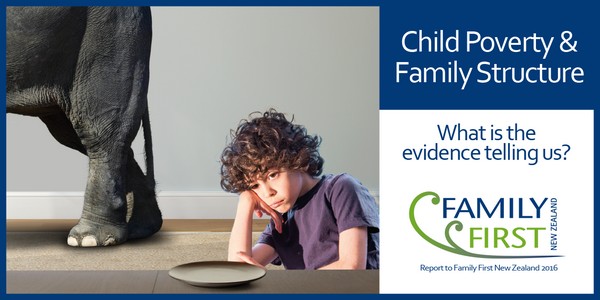NEW REPORT – Child Poverty: Don’t Mention Family Structure
 Media Release 30 May 2016
Media Release 30 May 2016
A report just released on child poverty and its causes argues that the ‘elephant in the room’ in the debate is family structure which is being constantly ignored, but that it is contributing significantly to increasing income inequality and child poverty and must be confronted.
The report by prominent welfare commentator and researcher Lindsay Mitchell entitled “CHILD POVERTY & FAMILY STRUCTURE: What is the evidence telling us?” examines household incomes and family structure from the early 1960s through to current day, and says that while unemployment, low wages, high housing costs and insufficient social security benefits are consistently blamed for child poverty, a major culprit – if not the major culprit – is family malformation, that is, a lack of two married committed parents.
Evidence produced in the report highlights:
- Despite families being much smaller, parents being older, mothers being better educated and having much higher employment rates, child poverty has risen significantly since the 1960s.
- In 1961, 95 percent of children were born to married couples; by 2015 the proportion had fallen to 53 percent. For Maori, 72 percent of births were to married parents in 1968; by 2015 the proportion had fallen to just 21 percent.
- In 2015, 27 percent of registered births were to cohabiting parents. But the risk of parental separation by the time the child is aged five is, however, 4-6 times greater than for married parents.
- Single parent families make up 28 percent of all families with dependent children. These families are the poorest in New Zealand.
- 51% of children in poverty live in single parent families.
- Single parents have the lowest home ownership rates and the highest debt ratios.
The research paper, commissioned by Family First NZ, draws the conclusion that NZ’s rapidly changing family structure has contributed significantly to increasing income inequality.
“Despite marriage being the best protector against child poverty, it has become politically unfashionable – some argue insensitive – to express such a view. But reducing child poverty rates will require encompassing analysis and debate,” says the author Lindsay Mitchell.
The author argues that the evidence supporting her premise is ‘overwhelming and incontrovertible’.
ENDS
READ the Full Report
READ the Executive Summary
Like Mike – Solo Parents
watchme.co.nz
Like Mike with another cobbled together, half thought through, centre-right commonsense opinion piece – this week he looks at Family First, and the harm the plague of solo parents is causing our society.
http://www.watchme.co.nz/entertainment/like-mike/solo-parents/
Bad research puts stigma on Maori marriage
http://www.waateanews.com/waateanews/x_story_id/MTM4MDc=/Bad%20research%20puts%20stigma%20on%20Maori%20marriage







